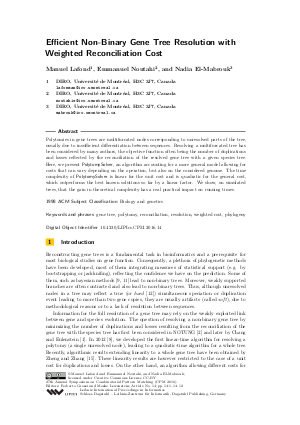Efficient Non-Binary Gene Tree Resolution with Weighted Reconciliation Cost
Authors Manuel Lafond, Emmanuel Noutahi, Nadia El-Mabrouk
-
Part of:
Volume:
27th Annual Symposium on Combinatorial Pattern Matching (CPM 2016)
Part of: Series: Leibniz International Proceedings in Informatics (LIPIcs)
Part of: Conference: Annual Symposium on Combinatorial Pattern Matching (CPM) - License:
 Creative Commons Attribution 3.0 Unported license
Creative Commons Attribution 3.0 Unported license
- Publication Date: 2016-06-27
File

PDF
LIPIcs.CPM.2016.14.pdf
- Filesize: 0.94 MB
- 12 pages
Document Identifiers
Subject Classification
Keywords
- gene tree
- polytomy
- reconciliation
- resolution
- weighted cost
- phylogeny
Metrics
- Access Statistics
-
Total Accesses (updated on a weekly basis)
0Document
0Metadata
Abstract
Polytomies in gene trees are multifurcated nodes corresponding to unresolved parts of the tree, usually due to insufficient differentiation between sequences of homologous gene copies. Apart from gene sequences, other information such as that contained in the species tree can be used to resolve such intricate parts of a gene tree. The problem of resolving a multifurcated tree has been considered by many authors, the objective function often being the number of duplications and losses reflected by the reconciliation of the resolved gene tree with the species tree. Here, we present PolytomySolver, an algorithm accounting for a more general model allowing different costs for duplications and losses per species. The time complexity of this algorithm is linear for the unit cost and is quadratic for the general cost, which outperforms the best known solutions so far by a linear factor. We show on simulated trees that the gain in theoretical complexity has a real practical impact on running times.
Cite As Get BibTex
Manuel Lafond, Emmanuel Noutahi, and Nadia El-Mabrouk. Efficient Non-Binary Gene Tree Resolution with Weighted Reconciliation Cost. In 27th Annual Symposium on Combinatorial Pattern Matching (CPM 2016). Leibniz International Proceedings in Informatics (LIPIcs), Volume 54, pp. 14:1-14:12, Schloss Dagstuhl – Leibniz-Zentrum für Informatik (2016)
https://doi.org/10.4230/LIPIcs.CPM.2016.14
BibTex
@InProceedings{lafond_et_al:LIPIcs.CPM.2016.14,
author = {Lafond, Manuel and Noutahi, Emmanuel and El-Mabrouk, Nadia},
title = {{Efficient Non-Binary Gene Tree Resolution with Weighted Reconciliation Cost}},
booktitle = {27th Annual Symposium on Combinatorial Pattern Matching (CPM 2016)},
pages = {14:1--14:12},
series = {Leibniz International Proceedings in Informatics (LIPIcs)},
ISBN = {978-3-95977-012-5},
ISSN = {1868-8969},
year = {2016},
volume = {54},
editor = {Grossi, Roberto and Lewenstein, Moshe},
publisher = {Schloss Dagstuhl -- Leibniz-Zentrum f{\"u}r Informatik},
address = {Dagstuhl, Germany},
URL = {https://drops.dagstuhl.de/entities/document/10.4230/LIPIcs.CPM.2016.14},
URN = {urn:nbn:de:0030-drops-60907},
doi = {10.4230/LIPIcs.CPM.2016.14},
annote = {Keywords: gene tree, polytomy, reconciliation, resolution, weighted cost, phylogeny}
}
Author Details
References
-
W.C. Chang and O. Eulenstein. Reconciling gene trees with apparent polytomies. In D.Z. Chen and D. T. Lee, editors, Proceedings of the 12th Conference on Computing and Combinatorics (COCOON), volume 4112 of Lecture Notes in Computer Science, pages 235-244, 2006.

-
K. Chen, D. Durand, and M. Farach-Colton. Notung: Dating gene duplications using gene family trees. Journal of Computational Biology, 7:429-447, 2000.

-
Paul F Cliften, Robert S Fulton, Richard K Wilson, and Mark Johnston. After the duplication: gene loss and adaptation in saccharomyces genomes. Genetics, 172(2):863-872, 2006.

-
Fred S Dietrich, Sylvia Voegeli, Sophie Brachat, Anita Lerch, Krista Gates, Sabine Steiner, Christine Mohr, Rainer Pöhlmann, Philippe Luedi, Sangdun Choi, et al. The ashbya gossypii genome as a tool for mapping the ancient saccharomyces cerevisiae genome. Science, 304(5668):304-307, 2004.

-
Bernard Dujon, David Sherman, Gilles Fischer, Pascal Durrens, Serge Casaregola, Ingrid Lafontaine, Jacky De Montigny, Christian Marck, Cécile Neuvéglise, Emmanuel Talla, et al. Genome evolution in yeasts. Nature, 430(6995):35-44, 2004.

-
D. Durand, B.V. Haldórsson, and B. Vernot. A hybrid micro-macroevolutionary approach to gene tree reconstruction. Journal of Computational Biology, 13:320-335, 2006.

-
Manolis Kellis, Bruce W Birren, and Eric S Lander. Proof and evolutionary analysis of ancient genome duplication in the yeast saccharomyces cerevisiae. Nature, 428(6983):617-624, 2004.

-
M. Lafond, K.M. Swenson, and N. El-Mabrouk. An optimal reconciliation algorithm for gene trees with polytomies. In LNCS, volume 7534 of WABI, pages 106122, 2012.

- Nicolas Lartillot and Hervé Philippe. A bayesian mixture model for across-site heterogeneities in the amino-acid replacement process. Molecular Biology and Evolution, 21(6):1095-1109, Jun 2004. URL: http://dx.doi.org/10.1093/molbev/msh112.
-
Michael Lynch and John S Conery. The evolutionary demography of duplicate genes. Journal of structural and functional genomics, 3(1-4):35-44, 2003.

-
F. Ronquist and J.P. Huelsenbeck. MrBayes3: Bayesian phylogenetic inference under mixed models. Bioinformatics, 19:1572 1574, 2003.

-
J.B. Slowinski. Molecular polytomies. Molecular Phylogenetics and Evolution, 19(1):114120, 2001.

-
Mike Steel and Andy McKenzie. Properties of phylogenetic trees generated by yule-type speciation models. Mathematical biosciences, 170(1):91-112, 2001.

-
Ilan Wapinski, Avi Pfeffer, Nir Friedman, and Aviv Regev. Natural history and evolutionary principles of gene duplication in fungi. Nature, 449(7158):54-61, 2007.

-
Y. Zheng and L. Zhang. Reconciliation with non-binary gene trees revisited. In Lecture Notes in Computer Science, volume 8394, pages 418432, 2014. Proceedings of RECOMB.

